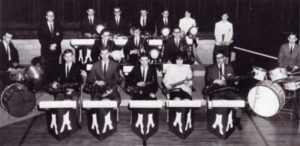 The Rogers drum show I recently attended brought back memories of my one and only visit to the factory in Covington. Ohio. I was there to pick up a very small but personally awe-inspiring drum kit. I have one advantage over any real drummers who set out to describe their gear. I don’t have to select a few significant pieces from a long list of equipment used over a long career. I have owned just three sets of drums in my life, and two of them are in the picture at right. I am not in the picture although someone who has appeared in this blog is. Lifelong friend Dale Baird, whom I’ve mentioned in tales of cars and mopeds, is at stage left of the front row.
The Rogers drum show I recently attended brought back memories of my one and only visit to the factory in Covington. Ohio. I was there to pick up a very small but personally awe-inspiring drum kit. I have one advantage over any real drummers who set out to describe their gear. I don’t have to select a few significant pieces from a long list of equipment used over a long career. I have owned just three sets of drums in my life, and two of them are in the picture at right. I am not in the picture although someone who has appeared in this blog is. Lifelong friend Dale Baird, whom I’ve mentioned in tales of cars and mopeds, is at stage left of the front row.
The picture of the high school stage band is from my senior yearbook. I was in the regular marching and concert band but not in the stage band. I was never asked, which I attributed to my already being a little too much rock and roll. However, since the school did not own a trap kit, my drums were asked to join. When the picture was taken, I no longer owned the Slingerlands on the photo’s right but did own the Rogers on the left.
 Of course, real drummers also have many advantages over me. One of them is photos. The stage band shot is the only one I’ve found of either of those kits. Because I’m absent in that picture, I’m including this one from the same yearbook. I’m on the photo’s left side next to the drums. Dave Thornhill, seated at the Rogers in the stage band photo, is on the other side of the drums. At the photo’s far right of that row is Ed Van Vickle who was seated at (and I believe owned) the Slingerlands.
Of course, real drummers also have many advantages over me. One of them is photos. The stage band shot is the only one I’ve found of either of those kits. Because I’m absent in that picture, I’m including this one from the same yearbook. I’m on the photo’s left side next to the drums. Dave Thornhill, seated at the Rogers in the stage band photo, is on the other side of the drums. At the photo’s far right of that row is Ed Van Vickle who was seated at (and I believe owned) the Slingerlands.
I bought the Slingerland kit from one of Dad’s coworkers. I don’t recall what I paid or the seller’s name but do recall that his offer to replace his initials with mine on the bass drumhead helped clinch the deal. The aging Slingerlands got me into my first band where I played standing up. That was partly because that’s what future McCoy Randy Zerhinger did and partly because I couldn’t afford a drum throne. I didn’t really need to sit down because I couldn’t afford a hi-hat either.
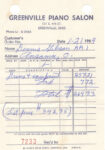 Memories of the next purchase were initially awakened a few months ago when I discovered the order at right. The drum show stirred them up considerably. The “Drums + equipment” covered by the bill was a blue sparkle three-piece set with no stands. There was a bass-mounted rod for a ride cymbal and both the single tom and the snare were mounted on the bass with Swivomatic ball joints. Swivomatic snare mounts were not unheard of (Here‘s one at the Covington show.) but were typically used on standup “cocktail” kits. I have never seen another bass-mounted snare like the one I had.
Memories of the next purchase were initially awakened a few months ago when I discovered the order at right. The drum show stirred them up considerably. The “Drums + equipment” covered by the bill was a blue sparkle three-piece set with no stands. There was a bass-mounted rod for a ride cymbal and both the single tom and the snare were mounted on the bass with Swivomatic ball joints. Swivomatic snare mounts were not unheard of (Here‘s one at the Covington show.) but were typically used on standup “cocktail” kits. I have never seen another bass-mounted snare like the one I had.
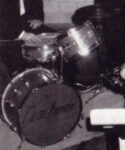 The detail at left is taken from the yearbook photo in an attempt to show this unusual arrangement. I don’t recall whether I chose the bass mount because it was cheaper than a stand or because I just thought it was cool. I will note that being so close to the factory made custom orders like this rather easy. It also made it possible to pick up orders there. It seems like I’ve forgotten a lot about the experience but I remember a fair amount too.
The detail at left is taken from the yearbook photo in an attempt to show this unusual arrangement. I don’t recall whether I chose the bass mount because it was cheaper than a stand or because I just thought it was cool. I will note that being so close to the factory made custom orders like this rather easy. It also made it possible to pick up orders there. It seems like I’ve forgotten a lot about the experience but I remember a fair amount too.
The guy from the Greenville Piano Salon (Eugene Brown?) picked me up (probably at school) in the store’s station wagon. I’m thinking 1960 Chevrolet but am far from certain. At the factory, we chatted briefly with someone I think was the plant manager. Since then, I’ve often wondered if that could have been Rogers and Covington legend, Joe Thompson. There was a set of drums in the office which I thought made it the coolest job in the world.
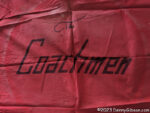 Somewhere along the way — probably even before I made the upgrade — I’d sprung for a throne and hi-hat. I played those blue drums through high school and the summer following graduation. As I wrote this, I recalled coming across that bass head cover a few years ago and I took a look inside a box marked “mementos”. There it was, a reminder that I need to empty that box pretty soon and of some good times in years gone by. The Coachmen was the group that Randy Hobbs left to join the McCoys and which I joined in the reorganization following his departure.
Somewhere along the way — probably even before I made the upgrade — I’d sprung for a throne and hi-hat. I played those blue drums through high school and the summer following graduation. As I wrote this, I recalled coming across that bass head cover a few years ago and I took a look inside a box marked “mementos”. There it was, a reminder that I need to empty that box pretty soon and of some good times in years gone by. The Coachmen was the group that Randy Hobbs left to join the McCoys and which I joined in the reorganization following his departure.
 After sitting idle through my freshman year of college, the blue Rogers saw some action during the summer then went silent again. But I guess I had decided I really wanted to play so it wasn’t too long before, in addition to all the other stuff going on — new wife and challenging classes, I accepted a former bandmate’s invitation to join his new group. I had outgrown the little kit with the bass-mounted snare and traded them in on my second and final set of new Rogers. These weren’t custom ordered from the factory but were still made to be just a little bit different. A common arrangement has two mounted toms of differing sizes. 12 and 13 inches were popular. A friend was playing in a band with a drummer who used two same-size toms with one just tuned a bit higher. I thought that looked cool. As I negotiated the purchase, I said I’d like two 13s rather than a 12 and a 13. I really expected this to be instantly shot down but it wasn’t. Without even attempting to change the agreed-upon price, the salesman swapped the 12-inch tom from the set I was buying for the 13-inch tom of a matching set. Whatever sense of uniformity I had was gone when I added a completely mismatched Gretch bass that I picked up really cheap. I guess it seemed like a good idea at the time. The marriage lasted just a couple years longer than the band and the black oyster (and white) drums were sold during the financial maelstrom of the divorce. My sporadic run at rock stardom was at an end. Rogers, over and out.
After sitting idle through my freshman year of college, the blue Rogers saw some action during the summer then went silent again. But I guess I had decided I really wanted to play so it wasn’t too long before, in addition to all the other stuff going on — new wife and challenging classes, I accepted a former bandmate’s invitation to join his new group. I had outgrown the little kit with the bass-mounted snare and traded them in on my second and final set of new Rogers. These weren’t custom ordered from the factory but were still made to be just a little bit different. A common arrangement has two mounted toms of differing sizes. 12 and 13 inches were popular. A friend was playing in a band with a drummer who used two same-size toms with one just tuned a bit higher. I thought that looked cool. As I negotiated the purchase, I said I’d like two 13s rather than a 12 and a 13. I really expected this to be instantly shot down but it wasn’t. Without even attempting to change the agreed-upon price, the salesman swapped the 12-inch tom from the set I was buying for the 13-inch tom of a matching set. Whatever sense of uniformity I had was gone when I added a completely mismatched Gretch bass that I picked up really cheap. I guess it seemed like a good idea at the time. The marriage lasted just a couple years longer than the band and the black oyster (and white) drums were sold during the financial maelstrom of the divorce. My sporadic run at rock stardom was at an end. Rogers, over and out.
Although the title of the post is a near-perfect fit, it’s not the least bit original. I know it from the name of a track on an early Beach Boys album that I used to try to copy as a teenager. I suspect I’m not the only one to remember this Denny’s Drums.

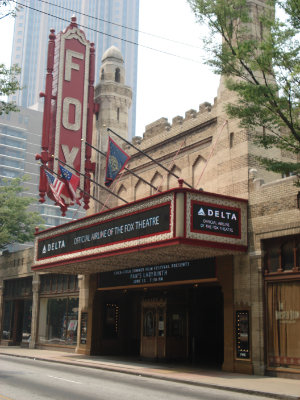

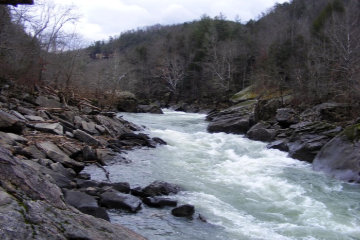 I see this new series as a place to dredge up any old thing that my thoughts bump into, but I’m going to stick with white water adventure for one more chapter. This story involves Kentucky’s
I see this new series as a place to dredge up any old thing that my thoughts bump into, but I’m going to stick with white water adventure for one more chapter. This story involves Kentucky’s 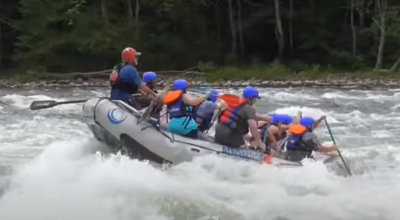 Like many, I’ve thought of writing a memoir. Maybe I already have. Considering that “a memoir is a form of creative nonfiction in which an author recounts experiences from his or her life”, each of the travelogues I’ve published might qualify. But it’s when I remember other, not necessarily travel-related, experiences from my life that the word memoir enters my head. That happened today. I’m reading Down the Great Unknown about John Wesley Powell’s pioneering trip down the Green and Colorado Rivers and just finished a section discussing the sensations of traveling through whitewater. It naturally made me recall some of my own whitewater experiences. There aren’t all that many, but there are a couple I’ve thought of writing down in the past. The dearth of new subject matter resulting from the current coronavirus quasi-quarantine combined with today’s memories prompted me to begin a series of “memoir posts” and kick it off with this rafting story.
Like many, I’ve thought of writing a memoir. Maybe I already have. Considering that “a memoir is a form of creative nonfiction in which an author recounts experiences from his or her life”, each of the travelogues I’ve published might qualify. But it’s when I remember other, not necessarily travel-related, experiences from my life that the word memoir enters my head. That happened today. I’m reading Down the Great Unknown about John Wesley Powell’s pioneering trip down the Green and Colorado Rivers and just finished a section discussing the sensations of traveling through whitewater. It naturally made me recall some of my own whitewater experiences. There aren’t all that many, but there are a couple I’ve thought of writing down in the past. The dearth of new subject matter resulting from the current coronavirus quasi-quarantine combined with today’s memories prompted me to begin a series of “memoir posts” and kick it off with this rafting story.